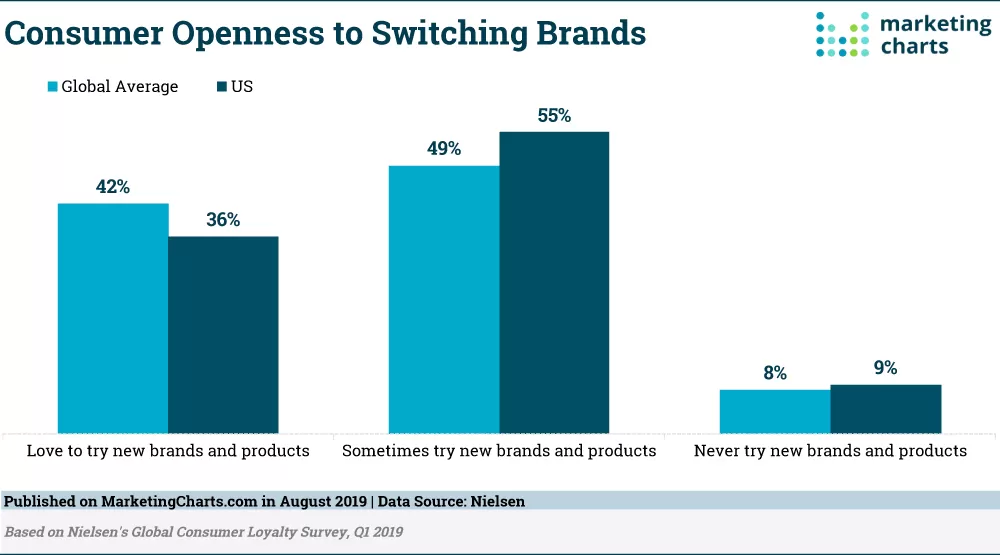Ecommerce has a dark secret, and there are reasons that some people like to keep it that way. If the truth got out then a lot of work and effort, to say nothing of strategies and employment could easily be perceived for what they are, redundant, irrelevant and unnecessary, they would be terminated.
So what is this poisoned chalice, that you should all be worried about? Quite simply there is little or no loyalty in ecommerce anymore. We are not making such a sweeping statement without acknowledging that there are several grey areas, that we shall come to. So putting potential disagreement aside for now, let us look at the ordinary person on an ordinary day.
They are not, like the beautiful image portrayed by the advertising, sophisticated people, mature, highly organised etc that have consciously decided to visit your site today to buy something. That’s not to say they won’t, but like muscle memory, their choice to do so can be a far more mundane reason such as they don’t know where else to go for it, yet. Many marketers practise hard to ensure this remains so.
Consumers who can organise their lives proficiently are rare, but then we all know life has this habit of coming along and destroying the best-laid plans in an instant anyway. Kids for example, as every parent on the planet knows all too well.
But for all of us with or without them, there are millions of reasons consumers don’t do what you most want them to do – which is come and spend their hard-earned cash with you because something else comes up. Be those things phone calls, friends, work, Strictly, other shows they must see, places they have to be, even the weather etc the list is endless. All of which destroys your hopes and dreams, and sometimes aspirations too.
When did you ever hear someone say “I’m going shopping at…” and then name the store? They don’t! Most people either name a brand or an item that they intend to purchase, if they ever even discuss it. Forget this argument about looking up referrals to make a decision. The actual decision is 99% made before that might raise its head.
People have already purchased thoughts, “I need some new jeans”, and “Jeans” in this case will be the exact brand they have a predilection for, and rarely if ever change. You hope at this point, that your website is their go-to location for this product. But the reality is that most people have half a dozen potential sources, if not more, and you’re just one. Annoyingly you won’t see that in your stats.
All you see is an AOV, and have to assume “That’s yer lot”. Commonly the consumer often merely enters their preferred brand into Google and skips you altogether. It just so happens that if your SEO or Google Shopping etc is good enough, they see your name on page #1 and go, “Oh yeah, I know them. They were OK”.
Heaven forbid you actually ever believe you are gullible enough to think their route to you was direct.

Source: https://www.marketingcharts.com/brand-related/brand-loyalty-109632
No matter the size of your enterprise, be it huge or tiny, consider yourself as if you are fishing on the river bank. (The fish – consumers). Some retailers have huge trawlers with massive nets, and others merely bait, hook, float and weight.
Regardless of where you are on that spectrum, before you are a myriad of consumers all swimming about. And either instinctively, or when they’re hungry, they will be attracted by your lure or bait and eventually take a nibble. If they feel like they are enjoying you’re offering you still hope they’ll be back, returning blindly, away from the millions of other hooks in the water offering every inducement known to mankind.
But like the fish, consumers have long memories too, and they forget why they don’t shop with you any more, but they remember they don’t.
The case for pro-active marketing
As an email service provider will advocate, that instead of waiting for customers to come to you, you can beat the rest by offering the products ahead of the competition. A huge benefit of doing this is the price point you can use.
An email from you alone, offers the opportunity to enjoy that human frailty of less scrutiny in checking the price, the decision is often simply “Do I like it, need it, want it or not”, without ever getting to the second phase, which is “I wonder if it’s cheaper somewhere else”. We are not advocating you do this blindly and continuously, lest it return to bite you.
Marketers tend to perceive that consumers will see this as detrimental to future shopping, that once a consumer feels ripped off, they won’t shop with that retailer again. Nevertheless, they often do it because despite this they do continue to shop with you, but you have planted the seeds of doubt as to whether they should shop around on price first.
Don’t be fooled into thinking this is the preserve of just other-world sites, ordering from unscrupulous companies or Johny Foreigner, as you’d be wrong. There are plenty of household names out there that try it on ever so subtly now and again, we’ve all been a victim.
“My style”, “my brand” or “my quality” is perceived as the cause of continued custom. Those facets may be, but again part of the dark secret, the consumer suffers from that human trait of apathy, laziness and tiredness.
They can’t be bothered to go and find it somewhere else. One of the causes of this is the fog of Google searches, and the volume of rubbish that gets in your way when you think you’ve entered something so simply into the search term only to find everyone and their dog suddenly want a piece of you, wholly unrelated to what you wanted in the first place. Remember your consumer’s distractions? Well, that’s another example.
The stats for email marketing offer all ecommerce retailers proof that it is, without doubt, the undisputed leader in go-to sales vehicles. Coming back to the fishing analogy, while you can look up and down the river bank and see all the lines in the water as far as the eye can see, who has got the better bait, better position, sophisticated techniques all in play, nothing is better than going directly to that fish lurking on its own and dangling your offer, without competition, right in front of it. So what then would be the worst things to come out of doing something seemingly so successful?
What they want to buy – not what you want to sell
So you have a beautiful, sleek, sophisticated “fishing net” ready to snare your catch as it passes, by which we include omnichannel opportunities, advertising, triggered response opportunities for email, marketing and promotional email offers and incentives, personalised content on your site for each viewer, or a fantastic distribution facility that can have the product on their doorstep in 24 hours.
The answer is hyper-personalisation. This is the art of using every facet of data collected through your platform, including much not stored even by the most advanced platforms themselves, but rather by specialist plugins that retrieve the information for you, analysing it to identify what each unique consumer is most likely to buy next and when. Imagine knowing exactly what each person will buy next, and having a means to be able to present that item to them, before anyone or anything else in the world gets a look in. Abhorring segmentation, as the practice of shutting the wrong people in a room together always works, not.
Only you have the benefit of the knowledge of everything going off on your website. There is a pattern created by each consumer’s activity, each visit for example typically leaves 100 impressions per visit, Each suggests a strategy both rare and personal to that one person. Not forgetting what they don’t look at or fail to be attracted to at that instant is equally important to clear the way for things that are.
You, as opposed to any of your competitors, have the benefit of their buying history. The two elements combined, show a unique profile that a clever AI Machine learning hyper-personalisation solution can use to rank every SKU on your site, in order of what products that person will buy, but for it being offered to them.
Now flip that on its head and consider it from the customer’s perspective. What will be the effect of showing them what they want, when they want it? No hullabaloo, no shouting, not waving your arms around in an attempt to attract their attention, no subversion of what they would otherwise have done. It amounts to the ultimate expression of customer appreciation.
So if you are going to keep someone coming back, do you think it will it be because of a. the retailer that simply offered them a product because they bought it before, or b. the retailer who watches every bit of shopping data to accurately anticipate their next choice? McKinsey stats illustrating it is twenty times the volume of sales proves that b. the latter is the only possible choice.





